Diamond Appraisals Near Boston, MA
The Jewelers & Loan Co. Quincy, MA is The Diamond Exchange for Cash
For hundreds of years, diamonds have been one of the most valued precious natural stones in the world. We buy diamonds for cash exchange here at 509 Beale St. in Quincy. There is no denying the brilliance, beauty or rarity of these stones-diamonds, which is why many will pay hundreds of thousands of dollars for these beauties. After all—a diamond truly is forever.
Whether you are interested in selling loose diamonds, want to pawn an old diamond engagement ring from a previous relationship, or looking to make custom made diamond jewelry from our Quincy, MA store, here at The Jewelers & Loan Co. we want to make sure that every person considering buying, selling, or pawning diamonds is fully educated on proper diamond selling and buying. There are a lot of characteristics to focus on, and it can be overwhelming, but if you have the right mindset and want to spend your money in the most efficient way to ensure you have a higher resale value if you upgrade down the line, sell due to an emergency, or even pawn or borrow against your diamond, it’s important to purchase the diamond with the correct mix of attributes.
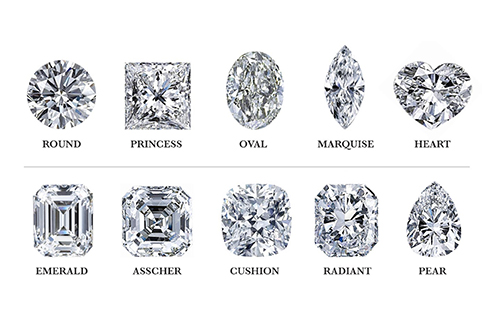
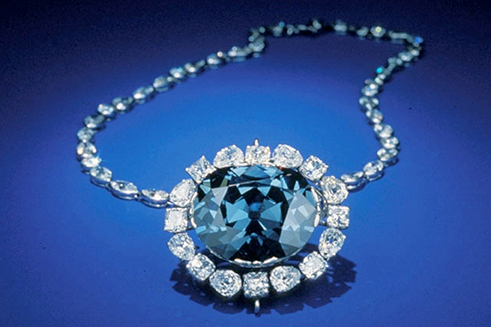
An introduction to the diamond cash exchange.
The world’s fascination with diamonds has been going on for centuries. But what makes diamonds so special? Some may like the look. Others may value the rarity. Certain consumers may value their association with commitment and love. Some may even like the status that comes with them, or perhaps the way in which they are formed in nature. There are so many reasons to love diamonds and so many factors that influence people’s love for these stones. There are also many factors that make diamonds valuable, especially today.
Before you start diving into the specifics of what makes a diamond a diamond and what makes these stones unique, there are a few different key terms that can help you through your diamond education if you’re looking to custom make an engagement ring, buy diamond earrings, or pawn borrow on your diamond. BlueNile and their private equity partnership has transformed the diamond buying experience and has affected a lot of local jewelers. Now, more than ever, consumers are able to price shop based on the information provided online. Although a great business, buying diamonds solely based on the provided certificates is not a good idea. You should buy diamonds based on the stone. GIA Certificates, which are also called diamond reports, are issued by an accredited independent gemological laboratory. In addition to the diamond’s carat weight and measurements, a certificate includes grades for the diamond’s cut, color, and clarity. These certificates are very vital to diamond pricing; however, you want to buy the stone, not the certificate! When you see a diamond in person, you are actually experiencing the life of the stone and how the facets attract or don’t attract light. There is nothing quite like seeing how a diamond looks up close and personal. With a certificate, the in-person visual is totally discounted. For example, when a stone is so-called “milky” the GIA certificate will not report this. One could liken the issue of “milkiness” to an ice cube. You may ask yourself, how clear is the ice cube with respect to its composition? Are there streaks or cloudiness? There are many factors to consider when looking at diamonds, but diamond-philosophy, your loved one’s preferences, and long term objectives should be considered when making a purchase.
Below we have a list of the parts of the diamond that every person buying diamonds or selling diamonds should know. Here at The Jewelers & Loan Co of Quincy, Massachusetts, we know it can be overwhelming, so we won’t quiz you on this later. However, we do want to make sure you are educated on the different terms that you will not only hear our diamond engagement ring and diamond jewelry buyers use but other diamond buyers and diamond sellers in the business users as well. We respect Signet Jewelers, who owns Kay, Zale’s, Jared’s, & Piercing Pagoda along with other brands, but we would urge you to consider bringing your business to an experienced local jeweler or pawnbroker in your community, even if it’s not with us.
- Brilliance – The brilliance of a diamond is the brightness that is created when you look at the stone or the sparkle. It is created by a combination of the white light reflections from the surface of the diamond and the inside polished portion of the diamond.
- Certified Diamond – When you are dealing with a certified diamond it means it has undergone quality analysis by a gemological laboratory and has a lab report or certificate with it. If you have this diamond certification, bring it in with you to our shop. Typically, diamonds are certified by the Gemological Institute of America (GIA), AGSL (American Gem Society Laboratory), EGL (European Gemological Laboratory), IGI (International Grading Laboratory), Diamond Grading Report, Report Numbers, or a GIA Diamond Grading Report.
- Crown – The crown is the top part of the diamond above the girdle but below the flat top of the diamond. The crown goes around the outside of the stone (much like a crown shape).
- Cutlet – This is a small facet located at the bottom of a finished diamond.
- Facet – A flat, polished surface on a finished diamond.
- Fire – When you look at a diamond and see flashes of color inside the polished diamond, this is known as the fire.
- Girdle – This is the “setting edge” of your diamond or what you use in order to put it in prongs or a setting. It is a very narrow section of a finished diamond that creates a boundary between the crown and the pavilion.
- Pavilion – This is the lower part of a faceted diamond, located right below the girdle.
- Scintillation – When you move a diamond and see those little flashes of light when it moves, this is scintillation.
Now that you have a basic understanding of some of these terms, it is time to move on to perhaps the most important concept of diamond buying and diamond selling- the Four C’s.
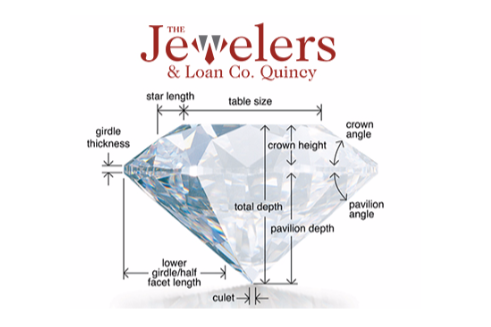
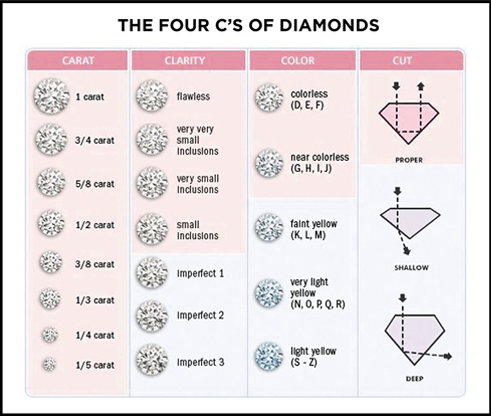
The Four C’s of Diamonds
If there is one term that you will hear often regarding diamonds and diamond value, it is likely the “Four C’s that most jewelers, pawnbrokers, or diamond buyers will discuss with you.
If you aren’t already familiar with them, the following are the “Four C’s”.
- Carat
- Cut
- Color
- Clarity
However, most diamond buyers and diamond sellers will only walk you through what these “Four C’s” are, they won’t actually educate you on what they mean and how you can use them to your advantage when both buying and selling diamond jewelry. You may benefit from going to a local jeweler who has the knowledge to provide information to you when buying or selling.
At The Jewelers & Loan Co. of Quincy, we value our customers and want to help them make the best decision possible regarding their diamond transaction. This is why we are more than happy to walk you through what the “Four C’s” really means.
Carat Weight or Diamond Size
The most obvious “C” of diamonds is carat weight. From the moment you see someone’s glittering diamond ring, chances are you may ask, “how many carats?” Size is probably is the most talked about the trait in diamonds.
Carat weight is perhaps the biggest indicator of value in diamonds, but it is important to remember that it is not the only indicator. In most situations, the bigger the diamond, the more expensive it is, but just because a diamond has a high carat weight, it doesn’t necessarily mean that it is going to be expensive.
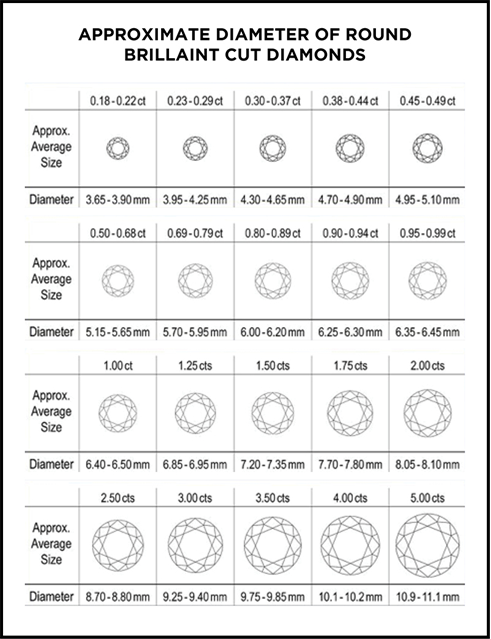
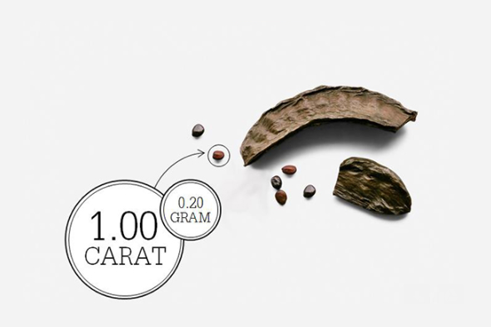
What is a carat?
Diamonds are measured in carats, which is actually a really small measurement – 1 carat is only 1/5 of a gram and 1/142 of an ounce. But in diamond terms, a carat or even a percentage of a carat is actually a pretty big deal. Our recommendation is to pay attention to the size of the stones rather than buy Carat Total Weight. This is one of the biggest mistakes consumers make which may lead them to wonder why their diamond engagement ring in the future is not worth anywhere near what they paid for it.
Carats are usually abbreviated “ct.” and their weights are typically expressed in decimals. 1.00 ct. is a one-carat diamond, a 1.51 ct. is a carat-and-a-half and so on. Diamonds that are less than a carat are typically expressed in points such as “that diamond weights 78 points or is a 78 pointer.” This means that the diamond is 0.78 cats.
If a diamond is right under a carat, or 0.98 ct. it will typically be called a “light carat.”
Specialty Stones
When it comes to assessing the value of a diamond, you may not always come across a piece that just has one large stone in it. This is very common in engagement rings and cocktail rings. The stone may have really small diamonds around it or have colored gems stones surrounding them as well. Again, Carat Total Weight of smaller stones of less than .20 ct. each has a significantly smaller resale cash value than one single diamond.
The following is what you need to know about rings like this.
Small Stones
If you have a piece of jewelry that is set with really tiny, faceted diamonds around it, those are typically called melee diamonds. They are often set in pieces to help make a larger central diamond pop. Typically, melee diamonds weigh less than 15 points in size, but it can vary. Melee diamonds still have value, but they aren’t going to have as much value as a large stone with the same weight.
For example, if you have a single stone that is 1.5 carats on a ring, it is going to be worth more than ten 15-point melee diamonds that equal 1.5 carats. This is important to remember when selling diamonds.
Gemstones
Many jewelry pieces contain both diamonds and other gemstones such as rubies and sapphires. While these stones don’t all hold the same value, one would still calculate what is known as the total gem weight of the piece, which is how many carats of diamonds and colored stones are in the single item. When determining the actual value of the piece for sale or trade-in, you will likely need to determine the weight of each type of gemstone and the weight of the diamonds to determine value. You should determine the resale value of the diamonds, the market value of the diamond, and the cash value of the diamond based on today’s prices for diamonds. As you may be able to tell, we are big fans of the diamond solitaire style, which is one diamond set in an engagement ring.
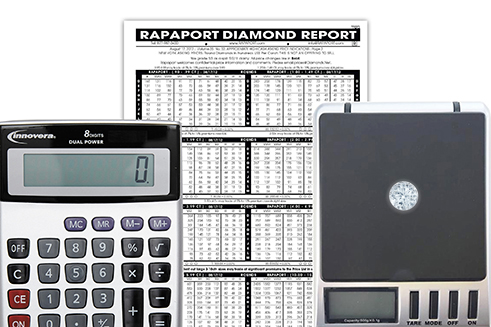
How to Compute the Cost of Your Diamond
Once you have a diamond that you are ready to buy, sell or trade in, pawn, or borrow, it is important to know how to compute the value. The first thing you need to know when selling a diamond is what the carat value of the diamond is. Higher quality or clarity equates to higher prices. The lower the quality or clarity, the more affordable the diamond is.
Carat values are not all the same, because there are so many different factors that come into play when determining value. This is something that you will continue to learn as we discuss cut, color and clarity.
Cost = Carat Weight x Per-Carat Price
For example, if you are selling diamonds that are valued at $3,0000 per carat and you have a 1.96 ct. diamond on your hands, you would be looking at a value of $5,880. If you want to determine the per-carat price of a piece, you would perform the following equation:
Total Price = Per-Carat Price x Carat Weight
For example, if you have a 3.12 diamond on your hands that is worth $12,540, this is how you would do the calculation.
$12,540 / 3.12 ct. = $4,019.23 (per-carat)
FAQs – Diamond buying advice made easy
Our advice for buying diamonds is as follows:
When you can, buy certified diamonds by The Gemological Institute of America Diamond Grading Laboratory. Aim for quality, which means SI2 Clarity & G or better Color.
Do not buy smaller diamonds that are sold as Carat Total Weight. This is a huge mistake made by consumers repeatedly. You will get more value by spending the money on a single quality diamond a half carat or larger.
My diamond engagement ring was appraised for $5,000 ten years ago. How much can I get for it today? One should be careful with appraisals. They are not always an indication of what the current market value of a diamond or piece of jewelry is.
Better Quality = Higher Price = Higher Resale Value
Lower Quality = Lower Price = Lower Resale Value
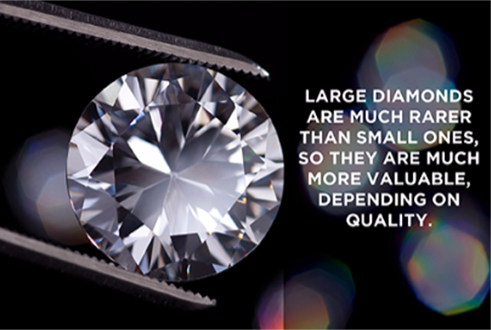
So, Bigger is More Expensive?
This isn’t necessarily the case. We would advise aiming for quality when buying and selling diamonds. This is one of the biggest misconceptions we see here at our Quincy, MA jewelry store. We have many customers that come in looking to buy diamonds or sell diamonds, always thinking that the bigger the carat weight, the more the diamond is worth.
Yes, a 2-ct. diamond is going to cost more than a 1 ct. diamond if all of the other factors are the same. However, if the color and clarity don’t match up, then the smaller diamond could actually be worth more. It is all about all of the diamond characteristics coming into play together.
For example, a new Ford Focus car may be the same size as a new Lexus, but it doesn’t mean that the two cost the same. The Lexus is going to have nicer upgrades and other features that you may not see initially from the outside, all in the same sized package. Perhaps the Lexus has leather seats, navigation and better gas mileage on it. You wouldn’t see it from the outside, but the Lexus has a number of things that make it a nicer car and that will make it cost more.
When you are buying diamonds or selling diamonds, you are buying or pawning more than just size. Remember, you need to think about if you want to upgrade in the future. The more factors in a diamond that make it desirable, the more expensive it could be.
Diamond Dimensions
- The weight of a diamond has a lot to do with its value, which is why at our Quincy, MA store, we will use a diamond scale for our customers to make sure they get the most accurate reading possible on their loose diamonds and diamond jewelry pieces. Diamonds are usually in mountings or in diamond engagement rings. We determine the size by using a millimeter gauge for estimating the carat weight of the diamond.However, precise weight is only a part of the overall picture, and it is important to know the accurate dimensions of any diamond as well. It can not only help you have a better understanding of the diamond you are buying or selling, but it can help you if you need to identify a stone or choose the proper size or type of mounting for a stone you are putting into a diamond engagement ring.Knowing the dimensions of a diamond will also help you determine how big the diamond will look when it is set. As most people know, the average person wants their ring to look bigger, but they don’t carry a diamond scale around with them to see how much it weighs.There are more than a few different dimensions that come into play with diamonds, and these measurements should be taken in the thousandths and rounded to the nearest hundredth of a millimeter.
- Depth – Measured from the top to the bottom, or the table to the cutlet. The depth of stone will also impact how it can or should be set. Depth percentage is one of the most important criteria for light to travel optimally through the diamond.
- Diameter – This is taken in round diamonds and is the measurement from one girdle edge to the opposite girdle edge, straight through the center. No matter how well cut the diamond is, no round diamond is perfectly round. The diameter measurement also allows jewelers to determine the prongs they can use to mount a diamond.
- Length and Width – These measurements are used when you are getting the dimensions of fancy shape diamonds, whether it is an oval diamond, princess cut diamond or any shape in between.
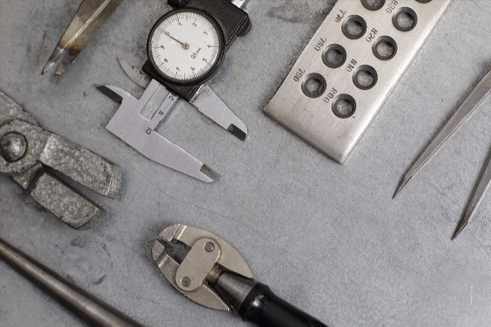
Diamond Tools Used to Measure Diamond Dimensions
The magnifying glass or whistle-shaped object that customers see around a Jewelers neck is called a loupe. There are a few different tools that can be used to measure dimensions. One of the most common, and one you may see at our Quincy, MA jewelry store is the millimeter gauge. It is a simple instrument that has jaws on it that hold the diamond in place to take the most accurate measurements possible across a variety of spots along with the diamond.
There are also hole gauges or templates that correspond to various diamond girdle measurements. Additionally, there are scanners or optical measuring devices that can help give a dimensional measurement on a loose diamond.
Cut
Of all of the components of the “Four C’s” the cut of a diamond is perhaps the most complex. There are so many elements that go into the cut of a diamond that impacts everything from its clarity to even its color.
While there are a number of different elements that make up the cut of a diamond, simply put, the cut of a diamond determines the interaction between the stone and the light around it. This also impacts the diamond’s overall appearance. Diamonds that have factors with what the diamond dealers call “triplex” meaning excellent cut, excellent polish, and excellent symmetry trade a premium for those characteristics.
Unfortunately, many jewelers actually gloss over the importance of cut when it comes to a diamond. When you come to our Quincy, MA jewelry store, you will find that we pay close attention to the cut of every stone, because we are educated enough in the world of diamonds to understand just how important it is.
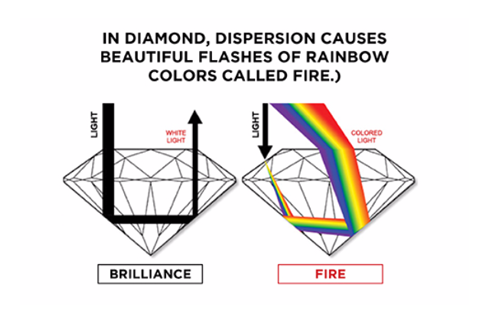
Cut and Lighting
Why do some diamonds have so much sparkle and life, while other diamonds look flat and milky? The first thing to understand about the cut of a diamond is that it truly impacts the way the light hits the stone. Who doesn’t love the sparkling look that a diamond has when the light hits it just right? We’ve all seen it before – when you enter a space with the perfect lighting and your diamond just can’t help but sparkle.
When a light ray hits a diamond, it either enters into the stone, or it reflects off the surface of that stone. When it reflects off the surface, it gives off that beautiful white light that we all love about diamonds.
The proportions of the cut of your diamond will impact how the light bounces off of the diamond and ultimately how much it sparkles. A well-cut diamond is one with good proportions, good symmetry, and a good polish, and it’s important to understand how these three elements come together to help make your diamond shine. We cannot emphasize enough the advice to spend money on a single quality diamond. For the last ten years, clients have come in after purchasing from a large publicly traded retail jewelry store only to find that the carat total weight diamond ring does not have as strong of resale value as customers may think. If you can, stay away from buying Carat Total Weight or small diamonds. Spend the money to buy platinum as it is currently, today, cheaper than gold.
Proportions, Polish and Symmetry of Diamond Cutting
A well-cut diamond has good proportions, but it should also be well-polished and have a certain amount of symmetry. There are several elements to a well-cut diamond. They include:
-
- The outline of the girdle. The girdle is where the diamond sits on its prongs and it should not impact the look of the diamond if it is cut properly. The thickness of the girdle is another consideration as too thick of a girdle can make large gray reflections in the stone. If the girdle isn’t cut to proportion, it can ultimately impact how much the stone shines.
- The table size is very important as it determines how much light enters and leaves the diamond. When it comes to table size, you want a stone with medium tables that let just enough light in to allow the stone to sparkle but not so much that it overwhelms the other components of the diamond.
- The crown angle is related to the height of the crown around the diamond. The higher the crown, the greater the crown angle. Diamonds with shallower crowns tend to be more fragile but more brilliant, while those with higher crowns tend to be more durable but less brilliant.
- The pavilion depth in a diamond is the distance between the girdle plane and the cutlet. If the pavilion depth is too deep it can make the center of the stone look dark.
- The length-to-width ratio is important in fancy shaped diamonds and the overall ratio can help with the look of the diamond. Depending on the shape of the stone, there are different desirable length-to-width ratios.
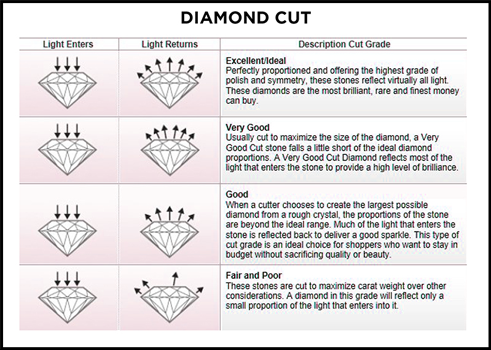
Diamond Polish
The polish of a diamond is essential for maximum brilliance, fire and scintillation. The polish of a stone is meant to describe the overall condition of the facet surfaces of the finished diamond. Here is how you rate the polish of a diamond:
- Excellent: Very few hard-to-find polish lines or tiny blemishes.
- Very Good: Very faint polish lines or insignificant blemishes in inconspicuous places.
- Good: Transparent polish lines on the crown can be seen through the pavilion and a few facets have polish marks or small blemishes.
- Fair: Obvious polish lines appear on several facets or noticeable blemishes can be seen on the stone.
- Poor: Polish marks and blemishes actually reduce the transparency of the stone.
Symmetry of a Diamond
The third element of a cut of a diamond is the symmetry. Diamonds are examined for their symmetry under 10x magnifiers. While we may feel that most diamonds look perfectly round or symmetrical, there is no such thing as a perfectly round diamond—there are always variations. This is how the ratings for symmetry with diamonds work:
-
- Excellent: May have one or two tiny extra facets and very few slightly misshapen facets.
- Very Good: Stone may have a few extra small or misshapen facets, there may be a few slight pointing problems or a very slight misalignment between the pavilion and crown.
- Good: The table or cutlet may be very slightly off-center, there could be several extra facets, minor issues with shape and pointing in the facets and a misalignment in the crown-to-pavilion proportions.
- Fair: When the crown-to-pavilion misalignment is fairly easy to see, the table or cutlet is slightly off-center, the girdle is wavy or there are many extra facets, misshapen facets or facets pointing in the wrong direction.
- Poor: When any issues with symmetry are very easy to see.
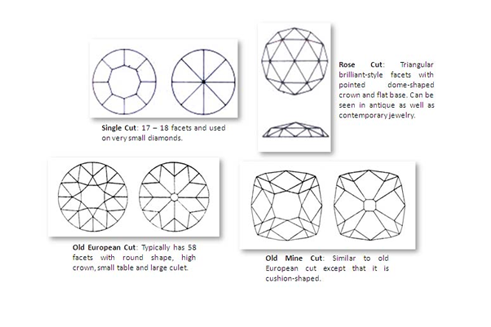
Types of Diamond Cuts
There are several elements that make up the cut of a diamond. For most people buying or selling diamonds, it is the type of cut that means the most. This is what you will likely discuss with your diamond sales professional and what you need to know about any loose diamond before you buy or sell them. Following is the breakdown of the different cuts:
Brilliant Cut – This type of diamond is cut with triangular or kite-shaped facets that start at the center and radiate outwards. Brilliant cuts can be used on any diamond shape.
Standard Round Brilliant Cut – A standard round brilliant diamond is the most popular diamond cut. It is round cut stone with either 57 or 58 facets on it.
Single Cut – This cut is typically used on very small diamonds and is used to depict a round stone with 17 or 18 facets on it.
Fancy Cut – Any diamond that is cut in a shape other than round. This can include Princess Cut, Cushion Cut, Pear Cut, Marquis Cut, Heart Shaped and Oval Cut diamonds.
Step Cut – This term is used to describe a cutting style that has long, narrow facets that are cut in rows parallel to the girdle. Typically, there are three rows in a stone.
Baguette – A baguette cut diamond features a small four-sided step cut that is either rectangular, square or tapered.
Mixed Cuts – These diamonds feature both brilliant and step facets.
Branded Cuts– Different manufacturers will develop and name their own cuts, such as Hearts on Fire diamonds. These branded cuts vary depending on the manufacturer.
Color
One of the biggest misconceptions about diamonds is that most people think all diamonds are colorless. Grading color is not easy to do on diamonds. A master GIA color grading scale is helpful in grading an accurate color for a diamond. We often get customers in our shop saying they have a colorless diamond when in reality, diamonds actually come in a wide range of colors.
Color has a lot of impact on the value of a diamond. Most people don’t even realize these slight color differences at first, but when you place two diamonds of two different colors next to each other, it can be very easy to tell the difference. Diamonds are less desirable when the stone is dark or grey looking compared to bright white. With social media and the active selfie lifestyle that exists in our culture today, it is wise to purchase a “G” or better on the color scale, which will be explained below. Your local diamond dealer may provide assistance in selecting the appropriate color.
True colorless diamonds are very rare and therefore very valuable. Most people don’t have colorless diamonds, they instead have diamonds that are in normal color range, which goes from colorless to light yellow all the way to light brown. They appear on a scale known as the D-to-Z scale that depicts the diamond’s hue.
The color scale is broken down into five sections, and most diamonds being bought or sold have an associated letter indicating the category of color. The following explains what those letters mean.
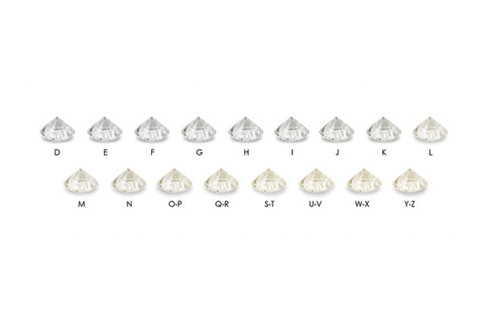
Colorless Diamonds (D-F)
The rarest colorless diamond will be rated “D.” However, any diamond that has a D, E or F rating is considered colorless.
Near Colorless (G-J)
Near colorless diamonds are going to appear colorless to the naked eye and are still very valuable. A Grating is the highest on the near-colorless scale. When mounted, G, H and I diamonds actually look colorless face-up. This is one of the biggest reasons why most labs don’t rate diamonds while they are mounted.
Faint (K-M)
Faint colored stones are where you start to see some light yellow hues in the diamonds. Most people will be able to see a faint coloration when they look closely at these stones, but many times if you mount them in the right setting such as yellow or rose gold, you can barely tell the difference.
Very Light (N-R)
Very light color-graded diamonds are going to look yellow. In some environments or lighting it may not be as noticeable as others, but they do have a hue to them.
Light (S-Z)
Diamonds with light color grading are going to look dark yellow or brown and they are going to be far less valuable, no matter what their size or cut. Keep in mind that we purchase and give pawn loans on all color diamonds that are a half carat or larger, whether they are certified or uncertified.
Fancy Colored Diamonds
When you want to buy diamonds, the less color you have in a standard diamond the better. However, there is an exception to this rule—fancy colored diamonds. There are some diamonds that are actually supposed to be colored such as the famous Hope Diamond, which is blue, or pink or fancy canary yellow diamonds.
There are so many different colors of fancy-colored diamonds and no matter the actual hue, the grader will give the fancy-colored stone a grading. The list below gives the possible rankings, going from lowest to highest. The first three grades (faint, very light and light) apply to every colored stone except yellow.
- Faint
- Very light
- Light
- Fancy light
- Fancy
- Fancy intense
- Fancy vivid
- Fancy dark
- Fancy deep
A note on color treatment – There are also treated diamonds that actually have color added to them to create a hue. These are much less valuable than naturally colored diamonds. We would advise that you avoid treated diamonds, lasered diamonds, filled diamonds, color enhanced diamonds, or other types in those categories.
You may see purple, turquoise, and other bold colored diamonds because of these coloring treatments. Some treatments are better than others, but one cannot derive the same value when selling diamonds that are artificially treated as opposed to fancy colored diamonds.
Clarity
Very few things in the world are actually perfect, including diamonds. In fact, “perfect diamonds”, no matter how expensive, are almost impossible to find. Almost every diamond you will see on the market today will have some sort of imperfection on them—this is where clarity comes in.
What does Diamond Clarity Mean?
The clarity of a stone is a collective term used to describe the different inclusions and blemishes that occur inside the diamonds. The better the clarity, the fewer the inclusions and blemishes.
- Inclusion is a characteristic that is enclosed inside a polished diamond that extends through the surface of the stone. In short, the imperfection is “included” inside the stone.
- A blemish, on the other hand, is confined to the surface of a polished gemstone and is a nick or imperfection that occurs on the outside of the stone just like a blemish typically occurs on the skin.
Typically, an inclusion has more of an impact on the beauty and value of a stone than a blemish, but it all depends on the individual diamond. The location of the inclusion is a factor as well. An inclusion located in center table is not desirable, as imperfections such as black carbon can be visually seen with the naked eye. Remember, it is generally best practice to purchase a diamond that has a certificate.
While these are the two most common types of clarity issues you will hear discussed in regards to diamonds, there are other imperfections that you should be aware of as well, and they are as follows.
-
- Bearding: When hair like lines develops along the girdle of a stone, it is known as bearding. This is an imperfection that typically occurs during the cutting process. When looking at a stone that is heavily “bearded” it will typically look like it is has a grey, fuzzy fringe along the outside of the stone.
- Cavity: When a diamond has a deep opening in its surface, it has what is known as a cavity. Typically cavities happen during polishing when the polisher touches a natural internal inclusion and causes it to get dislodged from the diamond. This leaves a hole in the surface of the diamond and when dirt and oil get trapped in there, it may make the hole look bigger and more noticeable.
- Chip: This is a small shallow blemish on the surface of the diamond, typically near the girdle. As the name suggests, it looks like when you chip off a piece of an ice block. It is typically the type of blemish that occurs from accidental knocks.
- Cloud: This is a broad term but one that can really make a difference in the look of a diamond. When you see a diamond that has clouding, you will notice it. These clouds are actually clusters or crystals or pinpoints that form very close together to create that “clouded” appearance.
- Crystal: This is a type of inclusion that happens when an actual mineral crystal is contained within a diamond. This can happen when diamonds are forming over time. They can be colorless, black, red or green depending on the type. The colored inclusions are usually noticeable to the naked eye.
- Feather: This is a small crack within the diamond. Sometimes, when the light catches on even a small feather, it is visible to the naked eye.
- Training: When a diamond has graining, it develops this imperfection from irregular crystal growth. Internal graining can cause the stone to be hazy or milky.
- Needle: When you see a needle inclusion under magnification, you will notice it. They are typically long and thin, like a needle, and are typically white or transparent. They are most visible at 10x magnification and may impact the look of the diamond to the naked eye.
- Pinpoints: A diamond with pinpoints has very small black or white crystals that are embedded inside the diamond. They look like small dots and individual pinpoints may not be visible unless viewed under 10x magnification. However, when a few pinpoints clump together, they can be very visible to the eye.
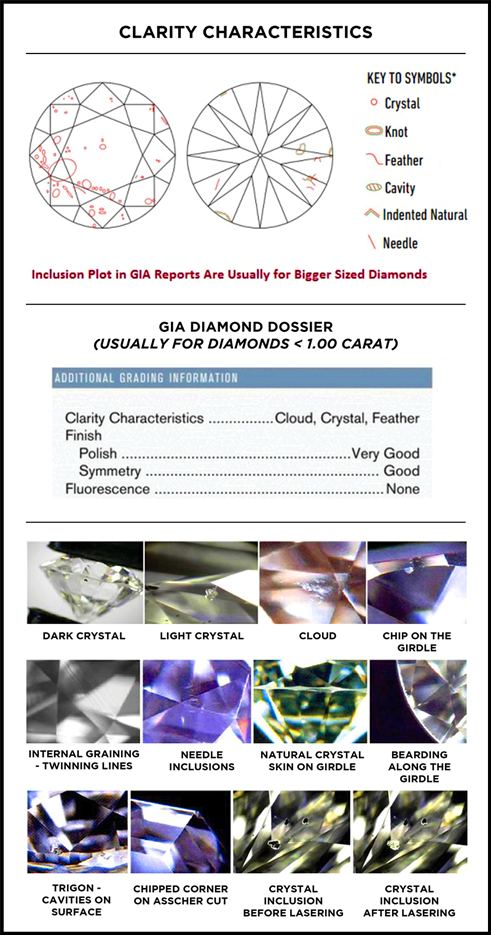
How to Rate Diamond Clarity
According to the Gemology Institute of America (GIA), Diamond Clarity has six different categories and 11 specific grades that will help you determine the clarity of your loose diamonds. The 11 categories are named and described below.
Flawless (FL): These diamonds are nearly impossible to find, and in fact, most jewelers and diamond buyers will spend a lifetime in the industry and never come across one. When a diamond is FL or Flawless, it has no inclusions and no blemishes visible under 10x magnification.
Internally Flawless (IF): This diamond is about as close to perfect as most people can find. When a diamond is IF, it means there are no inclusions visible under 10x magnification, although there may be some blemishes present at high magnification.
Very, Very Slightly Included (VVS1 and VVS2): When inclusions are so slight that a grader can barely see them under 10x magnification, they are given a VVS grading. A VVS1 is slightly better than a VVS2.
Very Slightly Included (VS1 and VS2): These inclusions can be seen very slightly under a 10x magnifier, but their impact and size are relatively minor. They are only barely visible under 10x magnification and are not visible to the naked eye. A VS1 has less visible inclusions or blemishes than a VS2.
Slightly Included (S1 and S2): These inclusions can be seen under 10x magnification, and they may be visible to the naked eye as well, depending on the type of blemish or inclusion. However, that doesn’t mean that the diamond can’t be beautiful. A common issue you will see in S1 and S2 diamonds is feathering which are breaks in the diamond.
Included (I1, I2, I3): With Included rankings, the inclusions in the diamond are very visible under 10x magnification. These types of inclusions may impact how transparent the diamond is and how brilliant it is or how much it shines. These are the lowest ranking of diamonds when it comes to clarity.
The thing to remember about the clarity of diamonds is that while differences may be very noticeable under 10x magnification, they are often barely noticeable to the naked eye. The average person may not notice the difference between a VS1 and an S1 without the help of a professional. That is why the diamond graders at our Quincy, MA shop are here to help make sure that you know exactly what the clarity is on your diamond.
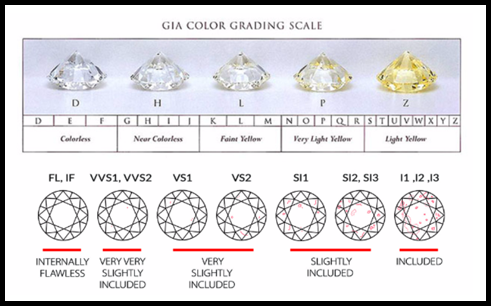
How much can I get for my diamond?
Diamond prices are determined by the carat weight, color, cut, shape, and the demand in the retail marketplace for the diamond. Better quality yields a higher price.
My engagement ring has two carats of total carat weight and I paid $7,500 for it. I want to get at least half of what I paid…
We always tell our customers to avoid buying diamonds based on carat total weight. Most customers do not think about the resale value upon making a purchase, and generally, there is a low resale value when you try to sell a carat total weight ring. These carat total weight items are higher profit items that large chains will typically sell to customers.
